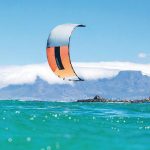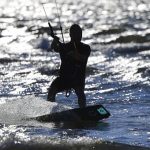A kitesurfing turn that I really enjoy and find satisfying is the ‘toeside to heelside’ turn. When you do it quickly and aggressively in the surf or a wave, it’s a great move. With a little practice, you can pull up a meter-high curtain of water.
That’s even more satisfying, especially if you also get a homemade rainbow. That often happens when the sun is shining. I’ve never gotten tired of this kitesurfing trick, which is why I’m trying to explain it to you in this special.
Are you interested?
The wave provides the perfect opportunity to turn your kiteboard around and hit the top of the wave, resulting in a beautiful spray. This has the advantage of preventing the nose of your kiteboard from getting caught in the wave, as well as providing you with extra speed to kitesurf in the other direction.
The Switch
If you remember the French cowboy Lucky Luke, you’ll know that he was very quick at shooting. Switching to this new game is like playing football with him – it’s very fast!
Stand with legs apart and feet pointing in opposite directions, as if you were riding a horse. Knowing that your preferred foot is the back foot, and the one you will attempt to swing around. On the count of three, you will turn 180, pivoting on your front foot. One, two three.
As you come round, you will notice that you have to bend your front leg, move your hips over your front foot, and push your back foot around. If you fall over, try looking at something eye level. This action is very similar to kicking a ball. The only difference is that your feet are further apart.
As you do you’ll feel your body naturally twist round, and your kite go up. We need to bring in Lucky Luke’s pistol to make this more kitesurf like. Your pistol hand should be on the same side as your front foot before the twist.
So stand as before, but with the pistol, and this time, try and shoot your shadow (imagine it’s behind you), extending your arm out in front. As you do you’ll feel your body naturally twist round, and your kite go up.
This text is talking about how to do a yoga move called a “twist.” To do the twist, you should feel more balanced, and your arm should help your body lead the twist. You should also be looking for your target, and your head should be ready and steady. You can practice this any time.
The Toe Side
Since we all have a bad case of body rash, it’s time to fix our toe side position. If you can, hook up a bar to something solid and try it on land. This will make it easier to adjust your body without the influence of a kite, wind, or waves.
Kit Set up and Hands
You should try to ride on your toes when you are feeling comfortable on the water. The size of your kite should not make much difference. You should try to keep it around 1 o’clock to 1:30, or 10:30 to 11 o’clock depending on which direction you are riding.
The lower you have your kite, the further around to toe side you’ll go, and the higher the easier it will be to slide the board. If you are using a big board (165cm or bigger), it may take a touch more effort to slide it all the way around.
To do a toe side, you need to keep the kite from moving too much. You might need to pull on the bar a bit to keep the kite going, so practice keeping your hands centered on the bar on either side of the chicken loop. Trim the bar down to where you can reach it.
How to Get Back
Although it can be helpful to learn how to switch and toe sides, it is also useful to know how to get back. There are several methods to do this, but two of the most effective are described below.
If you move the kite back to the other side of the window, follow it with your head, and switch your position, you will be able to pivot over your back foot by bending your back knee and dropping your weight over the rear of the board.
This is also a great way to fix the problem if you find that you have pulled too much on the backhand and the kite has risen; just keep pulling harder and you’ll be able to do a heel side carve.
To maintain speed and keep the kite moving forward, lean into your heels and switch your weight from the back foot to the front foot. You may go in the opposite direction for a brief moment before the board changes direction. With practice, you’ll be able to go heel-side again.
Top Tips
If you are falling forward, focus on keeping your weight over the heel-side edge of the board while you are switching. Only try to get your weight over your toes once the board has turned to follow the kite.
To start, if you’re able to switch directions and follow the kite slowly, you’ve accomplished a lot. It takes some practice to master a solid toe-side stance.
If you feel you are losing control of the kite, it is okay to put both hands back on the bar.
You need to be able to apply pressure to the center of the board with your feet in order to perform the maneuver properly.
If you stroke the water with your arms and keep your hips pushed down, you will be able to move through the water more easily. However, if you try to take the easy way out by breaking at the waist, you will have a more difficult time.
When you feel more confident, increase your speed and lower your kite slightly. This will make the whole process smoother, as the board will slide more easily during the switch phase, and the edge will grip more easily on the toe side phase.
You will also spend less time with slack kite lines.
Begin by pushing off your back leg more to maintain speed and transfer weight to your front foot. The board will be happier to plane and faster as a result.
If you get your toe side sorted out, it will open up a lot of opportunities for different types of kiting, like carving, wave riding, taking off from, and landing on the toe side.
Right conditions side to heelside bend
You can always do a side-to-heelside turn, no matter what the wind direction or waves are like. If you do it forcefully, you can always create something beautiful with a small water spraying up as a bonus.
However, if the wind is blowing from the side onto the shore, in the surf, and you time it right, this trick becomes even more beautiful. Then you can do it in the waves out at sea.
This explanation is not about that, but based on the explanation and images you can imagine how beautiful that is.
Toeside kitesurfing
It’s important to distribute your weight evenly when side kitesurfing. If you lean too far forward, your kiteboard will bite the water and you’ll slow down quickly. If you lean too far back, you’ll pull the nose of the board out of the water and come to a stop.
You can play around with your weight distribution to find what works best, but the key is to keep a good balance so you can maintain a reasonable speed without losing control.
When you’re ready, you can switch to toeside kiteboarding.
Switching from whole to toeside
ways In order to kitesurf sideways, you must first master jumping from heelside to toeside. TO do this, make sure your kite is not too low, as you will need some lift. With your kite at 10 or 2 o’clock, depending on your heading, slightly tighten the bar for extra power, and jump with your board by drawing your knees in slightly and then straightening them.
As soon as you have less pressure on the water, you can turn your back foot forward so that you can continue kitesurfing toeside. You don’t even have to jump if you only have very little pressure on your board to make this move.
Foot straps are not too tight
You should have a little bit of space in the foot straps when you do this process, so that your kiteboard is a little bit more flexible at your feet. This way, you can let it glide through the water, which will help you stay in control.
Start with a calm piece of water
To perform this trick, start in relatively flat water on, for example, a small surfboard. If you’re more advanced, you can jump from heelside to toeside on a wave and immediately turn around when you land back on the wave, as shown in the video introduction.
This will create more impact on the wave, allowing you to get a bigger boost from the trick.
Timing: don’t bother anyone
Look around you to see if you can turn quickly. You can use the kitesurfing priority rules to say that you have the right of way, because you’re surfing on a wave. However, if you’re going to turn around, you should always check first to make sure it’s possible.
It might not be if there are other kitesurfers close behind you, surfing in the same direction. If you’re not disturbing anyone, feel free to go ahead.
Timing: the kiteboard on the wave
The perfect time to reverse your kiteboard is just before a wave breaks. Start practicing on small waves or even on calm water. The game is also about finding the right position for your kite. In a wave or the surf, you should be able to turn your kiteboard and hit the top of the wave about halfway through the length of your kiteboard.
This way you’ll get the most beautiful spray. The advantage of this is that the nose of your kiteboard can stay in front of the wave and the speed of the wave also gives you direct speed to kitesurf in the other direction.
Timing: redirecting the kite
The kite should start turning when you do, and you should be aggressive but in control when sending it from one side of the wind window to the other.
It depends on the wind strength whether you have to send it over the top of the window or straight through. The lower the kite is when turning, the more aggressive the trick becomes.
Keeping balance and making speed
I am trying to keep the nose of the kiteboard out of the water so it does not snap into the water or the wave. I also want to make the spray from the kiteboard as big as possible. After I turn, I flatten the kiteboard to try and gain speed.
Send in a kite and continue kitesurfing
The kite also moves to the other side of the wind window to maintain power and speed, as well as to get back on course.



